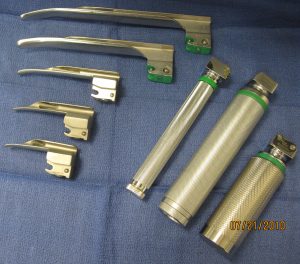This week’s Elemental EM discusses how to get more mental pediatric intubation practice.
Author: Courtney Cassella, MD (@Corablacas, EM Resident Physician, Icahn SoM at Mount Sinai) // Edited by: Alex Koyfman, MD (@EMHighAK, EM Attending Physician, UT Southwestern Medical Center / Parkland Memorial Hospital) and Brit Long, MD (@long_brit, EM Attending Physician, SAUSHEC, USAF)
Clinical Case:
An 84-year-old male with a past medical history of hypertension, coronary artery disease, diabetes, and mild cognitive impairment is brought in by ambulance presenting with lethargy. The patient had a cough productive of yellow phlegm for the past week. For the past 2 days he has had progressive lethargy, subjective fever, and increased work of breathing. When EMS arrived initially he was saturating 70% on room air that improved to 85% on non-rebreather. Vital signs on arrival are T 38° C, HR 135, BP 106/68, RR 32, O2 saturation 85% on non-rebreather. The patient is lethargic, not responding to questions, and in severe respiratory distress. The lung exam is significant for tachypnea, supraclavicular and intercostal retractions, and ronchi in the right lower lobe. After a goals of care discussion and brief pre-oxygenation with BiPAP the patient is intubated with first pass success via direct laryngoscopy. The endotracheal tube placement is confirmed and post-sedation medications are ordered.
This is a more common example of hypoxic respiratory failure and airway management seen in the adult population. For more information on intubation in general see:
http://www.emdocs.net/mindset-resuscitationist-organizing-room/
http://www.emdocs.net/post-intubation-analgesiasedation-regimens-ed-pearls-pitfalls/
Although one can feel there is never enough “practice” at intubation, pediatric intubation is even more rare.

One method to increase your practice of the pediatric intubation is to incorporate mental visualization with each adult intubation. The following is a way to mentally review pediatric intubations:
Instead of an 84-year-old male, a 4-year-old male comes to the emergency department in hypoxic respiratory failure secondary to a presumed pneumonia.
How are pediatric intubations different from adult intubations? What can you do to compensate?1-4
- Smaller airway diameter -> airway edema results in proportionately greater obstruction
- Congenital conditions affecting the tongue, mandible, neck: Down syndrome, Pierre Robin Syndrome
- Tumors, masses, swelling, edema: burns, chemical inhalation, allergic reaction
- Laryngomalacia, tracheomalacia
- Infection: group, epiglottitis, bacterial tracheitis, retropharyngeal abscess
- Infants and toddlers with large occiput
- -> Shoulder roll
- <2 years old have a large tongue
- -> Jaw thrust
- -> Sniffing position
- -> Oropharyngeal (or nasopharyngeal in older children) airway
- <8 years Larynx cephalad and anterior
- <8 years epiglottis is soft
- -> Use a Miller blade
- Narrow at the cricoid versus adults at vocal cords
- Prepare endotracheal tubes 0.5mm to 1mm larger and smaller
- Shorter trachea increases risk of right mainstem intubation
- Lower functional reserve capacity leading to faster oxygen desaturation
- -> Pre-oxygenate
- Small cricothyroid membrane
- -> Needle cricothyrotomy if <9 years
How would you select your equipment?1-4
Short answer: Broselow tape


- Alternatively, you can use the uncuffed formula and use 1 tube size smaller for cuffed endotracheal tubes.
*Practice stating the equipment/measurements for the child in your test case.
What medications would you use and what dose?1-4
Short answer: Broselow tape

The answer to this question is incredibly complex; however, here’s a short review:
- Atropine
- Infants and children can develop bradycardia from medication effects, vagal stimulation of the hypopharynx/epiglottis, and hypoxia
- Recommended in infants <1 year and consider in children <5 years
- Etomidate
- Sedative used most commonly for patients with hypotension or head trauma
- Risks adrenocortical suppression hence consider a different agent in sepsis5
- Ketamine
- Sedative used most commonly for patients with hypotension or severe asthma
- Risks tachycardia, hypertension, laryngospasm, and excessive salivation
- Propofol
- Sedative for status epilepticus or head trauma/increased intracranial pressure
- Not recommended for < 3 years old secondary to decreased clearance6
- Risks hypotension
- Benzodiazepines
- Sedative for status epilepticus
- Risks hypotension
- Succinylcholine
- Shorter duration of action
- Risks: Higher risk of malignant hyperthermia compared to other paralytics, hyperkalemia
- Rocuronium
- Longer duration of action
- Benzodiazepines (midazolam, lorazepam), ketamine, dexmedetomidine, propofol, and opiates (fentanyl, morphine) are commonly used for post-intubation sedation/analgesia regimens
References/Further Reading:
- Yamamoto LG. Airway Management. In: Schafermeyer R, Tenenbein M, Macias CG, Sharieff GQ, Yamamoto LG. Strange and Schafermeyer’s Pediatric Emergency Medicine, 4e New York, NY: McGraw-Hill; 2014. http://eresources.library.mssm.edu:2744/content.aspx?bookid=1345§ionid=72121654. Accessed June 28, 2017.
- Singh A., Frenkel, O. Evidence-Based Emergency Management of the Pediatric Airway. Pediatr Emerg Med Pract. 2013; 10(1): 1-25. PubMd: 26505568
- Kleinman ME, Chameides L, Schexnayder SM, et al. Part 14: Pediatric advanced life support: 2010 American Heart Association Guidelines for cardiopulmonary resuscitation and emergency cardiovascular care. Circulation. 2010;122:S876–S908. PubMed: 20956230
- Juergens AL, II, Glover J, Reddy MP. Compromised Airway. In: Stone C, Humphries RL, Drigalla D, Stephan M. CURRENT Diagnosis & Treatment: Pediatric Emergency Medicine New York, NY: McGraw-Hill; 2014. http://eresources.library.mssm.edu:2744/content.aspx?bookid=1175§ionid=65106444. Accessed June 28, 2017.
- den Brinker M, Hokken-Koelega AC, Hazelzet JA et al.: One single dose of etomidate negatively influences adrenocortical performance for at least 24h in children with meningococcal sepsis. Intensive Care Med. 2008;34(1):163. PubMed: 17710382
- Chidambaran V, Costandi A, D’Mello A. Propofol: a review of its role in pediatric anesthesia and sedation. CNS Drugs. 2015; 29(7): 543-63. PubMed: 26290263










2 thoughts on “Elemental EM: Pediatric Intubation”
Pingback: Intubation 101 – petits conseils pour étudiants en médecine | Docs d'urgence
Pingback: Pediatric Intubation – ER Dispo